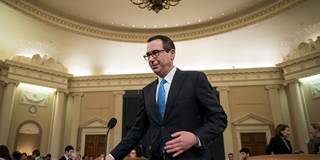Many observers have criticized the White House's budget plan for fiscal year 2018, owing to its optimistic assumptions about underlying economic growth. But the budget appears to be unrealistic in another crucial respect: interest rates – and thus debt-service costs – are supposed to remain low, even as full employment is reached.
CAMBRIDGE – US President Donald Trump’s administration has now released its budget plans for fiscal year 2018. Among the details provided in the document, entitled America First – A Budget Blueprint to Make America Great Again, are projections for the expected path of gross federal debt as a percentage of GDP, which is shown to decline from its current level of about 106% to about 80% in 2027. Debt held by the public is expected to mirror this path, shrinking from 77% to 60% over this period.
Unfortunately, neither projection is credible.
A sustained and marked decline in government debt (relative to GDP) would be welcome news for those of us who equate high indebtedness with the kind of fiscal fragility that reduces the government’s ability to cope with adverse shocks. But, as many critics have pointed out, the economic assumptions underlying the Trump administration’s benign scenario appear improbable. In fact, they are also internally inconsistent.

CAMBRIDGE – US President Donald Trump’s administration has now released its budget plans for fiscal year 2018. Among the details provided in the document, entitled America First – A Budget Blueprint to Make America Great Again, are projections for the expected path of gross federal debt as a percentage of GDP, which is shown to decline from its current level of about 106% to about 80% in 2027. Debt held by the public is expected to mirror this path, shrinking from 77% to 60% over this period.
Unfortunately, neither projection is credible.
A sustained and marked decline in government debt (relative to GDP) would be welcome news for those of us who equate high indebtedness with the kind of fiscal fragility that reduces the government’s ability to cope with adverse shocks. But, as many critics have pointed out, the economic assumptions underlying the Trump administration’s benign scenario appear improbable. In fact, they are also internally inconsistent.